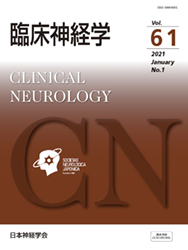Volume 61, Issue 12
Displaying 1-17 of 17 articles from this issue
- |<
- <
- 1
- >
- >|
Requested review <Historical note>
-
2021 Volume 61 Issue 12 Pages 815-824
Published: 2021
Released on J-STAGE: December 22, 2021
Advance online publication: November 06, 2021Download PDF (3773K) Full view HTML
Review
-
2021 Volume 61 Issue 12 Pages 825-832
Published: 2021
Released on J-STAGE: December 22, 2021
Advance online publication: November 18, 2021Download PDF (2139K) Full view HTML
Case Reports
-
2021 Volume 61 Issue 12 Pages 833-838
Published: 2021
Released on J-STAGE: December 22, 2021
Advance online publication: November 18, 2021Download PDF (2506K) Full view HTML -
2021 Volume 61 Issue 12 Pages 839-843
Published: 2021
Released on J-STAGE: December 22, 2021
Advance online publication: November 18, 2021Download PDF (2414K) Full view HTML -
2021 Volume 61 Issue 12 Pages 844-850
Published: 2021
Released on J-STAGE: December 22, 2021
Advance online publication: November 18, 2021Download PDF (2224K) Full view HTML -
2021 Volume 61 Issue 12 Pages 851-855
Published: 2021
Released on J-STAGE: December 22, 2021
Advance online publication: November 18, 2021Download PDF (2506K) Full view HTML -
2021 Volume 61 Issue 12 Pages 856-861
Published: 2021
Released on J-STAGE: December 22, 2021
Advance online publication: November 18, 2021Download PDF (2956K) Full view HTML -
2021 Volume 61 Issue 12 Pages 862-868
Published: 2021
Released on J-STAGE: December 22, 2021
Advance online publication: November 18, 2021Download PDF (4312K) Full view HTML -
2021 Volume 61 Issue 12 Pages 869-873
Published: 2021
Released on J-STAGE: December 22, 2021
Advance online publication: November 18, 2021Download PDF (1251K) Full view HTML
Brief Clinical Notes
-
2021 Volume 61 Issue 12 Pages 874-877
Published: 2021
Released on J-STAGE: December 22, 2021
Advance online publication: November 18, 2021Download PDF (1043K) Full view HTML
Proceedings of the Regional Meeting
-
2021 Volume 61 Issue 12 Pages 878-885
Published: 2021
Released on J-STAGE: December 22, 2021
Download PDF (1770K) -
2021 Volume 61 Issue 12 Pages 886-891
Published: 2021
Released on J-STAGE: December 22, 2021
Download PDF (1229K)
Notice
-
2021 Volume 61 Issue 12 Pages 892-901
Published: 2021
Released on J-STAGE: December 22, 2021
Download PDF (341K) -
2021 Volume 61 Issue 12 Pages 902-906
Published: 2021
Released on J-STAGE: December 22, 2021
Download PDF (254K) -
2021 Volume 61 Issue 12 Pages 907
Published: 2021
Released on J-STAGE: December 22, 2021
Download PDF (134K)
Editor’s Note
-
2021 Volume 61 Issue 12 Pages 908
Published: 2021
Released on J-STAGE: December 22, 2021
Download PDF (161K)
Erratum
-
2021 Volume 61 Issue 12 Pages 909
Published: 2021
Released on J-STAGE: December 22, 2021
Download PDF (61K)
- |<
- <
- 1
- >
- >|
